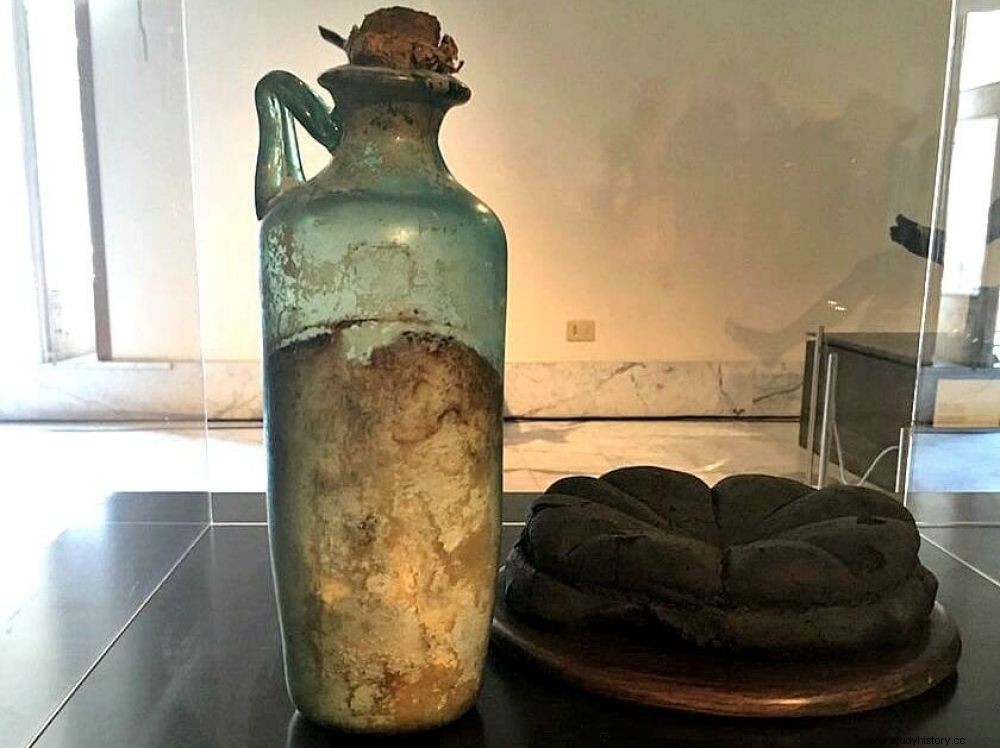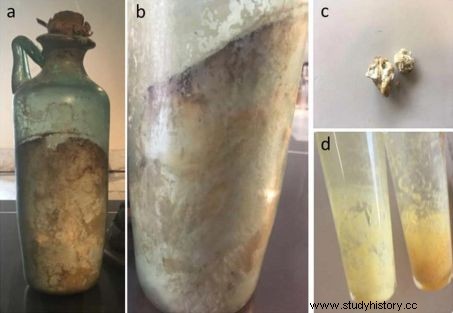Undoubtedly found in the 18th century on the ancient site of Herculaneum, near Pompeii, this olive oil was produced nearly 2,000 years ago and frozen in its bottle by the famous eruption of Vesuvius in 79 AD. C. No less than 0.7 liters have stood the test of time.

The bottle of olive oil enthroned in the National Archaeological Museum of Naples alongside a charred loaf of bread.
It is astonishing that never before has anyone questioned the nature of its content. The latter was however worth a look, since it is neither more nor less than the oldest olive oil ever preserved in the world. This oil has been identified in a glass bottle kept in the National Archaeological Museum of Naples (Mann) and coming from the ancient site of Herculaneum, destroyed by the eruption of Vesuvius in the year 79 AD. Manufactured there almost 2,000 years ago, the nectar will not have had time to be tasted before the disaster.
A bottle that would have been exhumed from the site of Herculaneum
Unfortunately, little information has been kept about the context of discovery of this bottle. The researchers behind a November 2, 2020 publication in the journal Science of Food suppose that it would have been exhumed from the site of Herculaneum during archaeological excavations carried out in 1710 under the impulse of the Prince of Elbeuf or a little later, in 1738, this time at the request of the King of Naples, Charles III of Bourbon. Exhibited in a museum display case, it ended up arousing the curiosity of Italian journalist and paleontologist Alberto Angela almost three centuries later, also the author of numerous books on ancient Rome. Because no one could provide him with an answer about the nature of the liquid contained in the bottle, a study was initiated under the direction of Raffaele Sacchi, professor at the Department of Agriculture of the University of Naples Frederic II, in collaboration with the National Research Council (CNR).
Obviously weathered oil
A series of chromatographic, spectroscopic and mass spectrometric analytical techniques confirmed that the residues did indeed resemble "the oldest olive oil sample we have found in large quantities. " , making the artifact housed in the museum "the oldest olive oil bottle in the world" . But let the more adventurous change their minds:impossible to taste this "oil" today. Very few molecules typical of olive oil remain in the bottle. Triglycerides, which make up 98% of the oil, have broken down into the constituent fatty acids. Unsaturated fatty acids, on the other hand, have completely oxidized, generating hydroxy acids which, over the past 2,000 years, have reacted by forming condensation products such as estolides (polyesters obtained from fatty acids), never observed before. previously in the conventional processes of natural alteration of olive oil.

Here is the detail of the organic content with a slanted surface indicating an original liquid state, a sample used for chemical analysis, and lipid extracts. Credits:Raffaele Sacchi.
"To an excellent approximation, radiocarbon dating placed the find at the time of the Plinian eruption of Vesuvius in AD 79." , states the study. This is solid proof of the importance of olive oil in the diet and culture of the ancient populations of this region of Campania, as many frescoes in Pompeii already testify.
